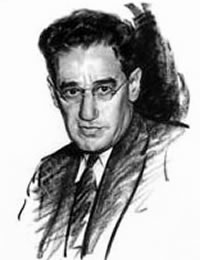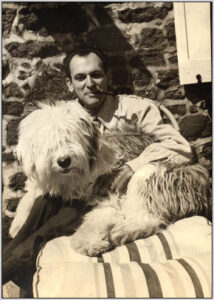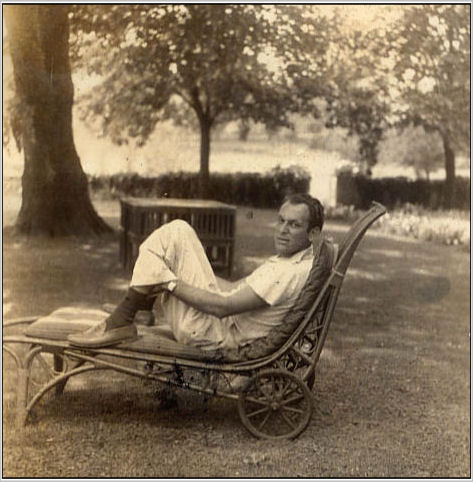Enter Moss Hart
Enter Moss Hart

George S. Kaufman
1889 – 1961
George S. Kaufman’s Biography
Enter Moss Hart
 However, by the time the 1930s began, Kaufman’s spirits were relatively high. Financially, he was fairly unaffected by the stock market crash. Professionally, he was much in demand as a director after helming Hecht and MacArthur’s 1928 smash, The Front Page, and he was revered for his talent as a play doctor. But the most significant event of the 1930s for Kaufman actually occurred in 1929, when a young writer named Moss Hart sought Kaufman as a collaborator for a comedy he had written about the introduction of talking pictures to a panicked Hollywood.
However, by the time the 1930s began, Kaufman’s spirits were relatively high. Financially, he was fairly unaffected by the stock market crash. Professionally, he was much in demand as a director after helming Hecht and MacArthur’s 1928 smash, The Front Page, and he was revered for his talent as a play doctor. But the most significant event of the 1930s for Kaufman actually occurred in 1929, when a young writer named Moss Hart sought Kaufman as a collaborator for a comedy he had written about the introduction of talking pictures to a panicked Hollywood.
Kaufman’s partnership with Hart led to eight projects in the ensuing decade, arguably among his best, certainly among his most successful. The Hollywood spoof, Once in a Lifetime–with Kaufman directing and acting in the supporting role of a Broadway playwright–was a smash hit of the 1930 season.
Hart’s trials and tribulations with his older, vastly more experienced partner during the show’s creation are beautifully set down in his 1959 memoir Act One. Hart’s taste for epic pageantry led to their 1934 play, Merrily We Roll Along, which traced the fall and rise of a Broadway playwright through the century by telling his story in reverse chronological order. The play was not successful, but had a second burst of notoriety when Stephen Sondheim turned it into a musical in 1981.
That ambitious play’s failure was more than mitigated by the team’s next effort, You Can’t Take It with You in 1936. Kaufman’s (and Hart’s) greatest financial bonanza, the play is arguably one of American drama’s greatest plays and certainly one of its most characteristically American. The play-a culture clash between two clans, one anarchic and one conservative, captured both audiences (it ran 837 performances) and, for Kaufman, his second Pulitzer Prize.
After writing the book for a provocative musical portrait of President Franklin D. Roosevelt in I’d Rather Be Right (1937), with a score by Richard Rodgers and Lorenz Hart, the team’s next major creation used the character of their old friend Alexander Woollcott as the basis for a play about an egomaniacal celebrity and raconteur who invades the domain of a quiet Midwestern family. The Man Who Came to Dinner (1939).
Kaufman and Hart’s final collaboration, George Washington Slept Here (1940), was a popular but unambitious tale of the inconveniences of country life. Like Marc Connelly before him, Hart left Kaufman amicably, with great admiration for his partner’s work, but, more insistently, with a need to write his own material.
 However, by the time the 1930s began, Kaufman’s spirits were relatively high. Financially, he was fairly unaffected by the stock market crash. Professionally, he was much in demand as a director after helming Hecht and MacArthur’s 1928 smash, The Front Page, and he was revered for his talent as a play doctor. But the most significant event of the 1930s for Kaufman actually occurred in 1929, when a young writer named Moss Hart sought Kaufman as a collaborator for a comedy he had written about the introduction of talking pictures to a panicked Hollywood.
However, by the time the 1930s began, Kaufman’s spirits were relatively high. Financially, he was fairly unaffected by the stock market crash. Professionally, he was much in demand as a director after helming Hecht and MacArthur’s 1928 smash, The Front Page, and he was revered for his talent as a play doctor. But the most significant event of the 1930s for Kaufman actually occurred in 1929, when a young writer named Moss Hart sought Kaufman as a collaborator for a comedy he had written about the introduction of talking pictures to a panicked Hollywood.
Kaufman’s partnership with Hart led to eight projects in the ensuing decade, arguably among his best, certainly among his most successful. The Hollywood spoof, Once in a Lifetime–with Kaufman directing and acting in the supporting role of a Broadway playwright–was a smash hit of the 1930 season.
Hart’s trials and tribulations with his older, vastly more experienced partner during the show’s creation are beautifully set down in his 1959 memoir Act One. Hart’s taste for epic pageantry led to their 1934 play, Merrily We Roll Along, which traced the fall and rise of a Broadway playwright through the century by telling his story in reverse chronological order. The play was not successful, but had a second burst of notoriety when Stephen Sondheim turned it into a musical in 1981.
That ambitious play’s failure was more than mitigated by the team’s next effort, You Can’t Take It with You in 1936. Kaufman’s (and Hart’s) greatest financial bonanza, the play is arguably one of American drama’s greatest plays and certainly one of its most characteristically American. The play-a culture clash between two clans, one anarchic and one conservative, captured both audiences (it ran 837 performances) and, for Kaufman, his second Pulitzer Prize.
After writing the book for a provocative musical portrait of President Franklin D. Roosevelt in I’d Rather Be Right (1937), with a score by Richard Rodgers and Lorenz Hart, the team’s next major creation used the character of their old friend Alexander Woollcott as the basis for a play about an egomaniacal celebrity and raconteur who invades the domain of a quiet Midwestern family. The Man Who Came to Dinner (1939).
Kaufman and Hart’s final collaboration, George Washington Slept Here (1940), was a popular but unambitious tale of the inconveniences of country life. Like Marc Connelly before him, Hart left Kaufman amicably, with great admiration for his partner’s work, but, more insistently, with a need to write his own material.
Contact Us Today
Interested in bringing George S. Kaufman’s timeless plays to your stage?
Please refer to the contact information for each specific play on the various collection pages for direct amateur and professional licensing information.
Plays are represented by Concord Theatricals, Broadway Dramatic Licensing, and Music Theatre International respectively
If you are interested in first-class performance or film/television rights:
In the US, George S. Kaufman’s plays are represented by:
CPK Artists, LLC
In the UK, George S. Kaufman’s plays are represented by:
Alan Brodie Representation
For more information about George S. Kaufman or this website, contact:
Laurence Maslon
Literary Trustee, George S. Kaufman Estate










